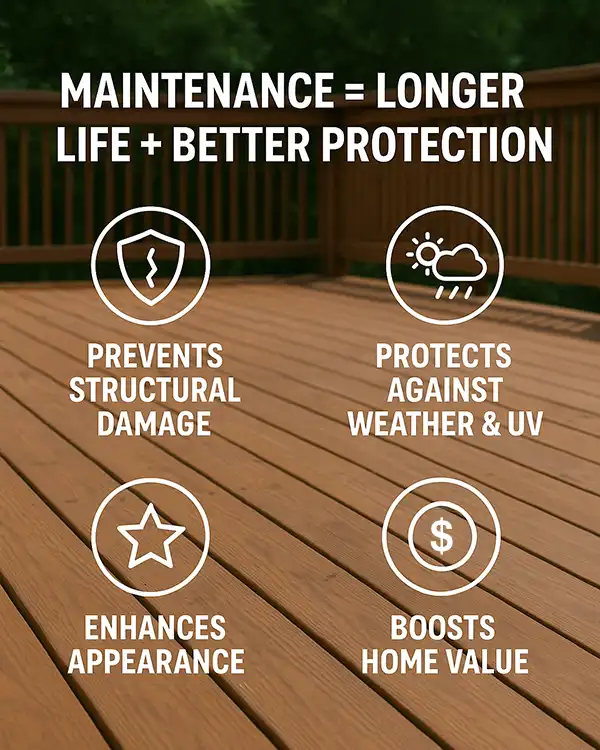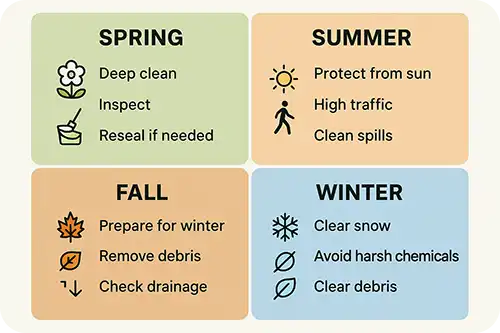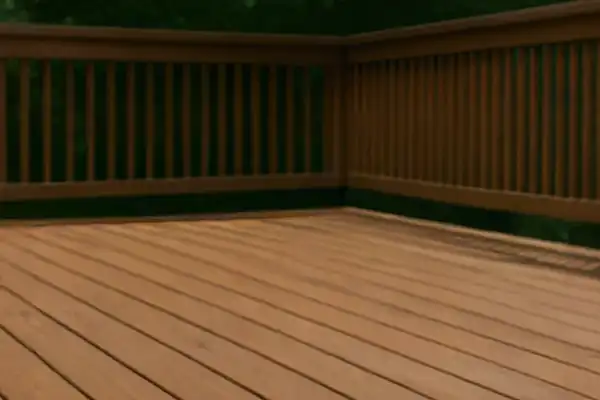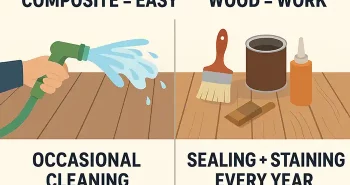A wooden deck is a great way to enhance your outdoor space, and while proper deck installation and repair are essential to safety and durability, regular maintenance is just as important. With the right care, most wooden decks can last 15 to 30 years or more, depending on the type of wood and level of upkeep. Here, we’ll provide some tips to help you maintain and protect your wooden deck based on season and wood type.
Key Takeaways: What Are the Most Important Action Items to Maintain and Protect a Wooden Deck?
Regular maintenance prevents structural damage, protects against weather and UV exposure, and extends your deck’s lifespan. Some of the most important tips to do this include:
✓ Wood type matters: Pressure-treated wood, cedar, redwood, and exotic hardwoods each have unique care needs, while composite decking requires minimal maintenance.
✓ Cleaning, staining, and sealing are essential: clear debris, scrub with appropriate cleaners, and apply sealant or stain to protect your deck.
✓ Seasonal care keeps your deck safe year-round:
– Spring: Deep clean, inspect, and reseal if needed
– Summer: Protect from the sun and high traffic
– Fall: Prepare for winter, remove debris, check drainage
– Winter: Clear snow carefully and avoid harsh chemicals
✓ Low-maintenance tips include using furniture pads, protective mats, shade solutions, and quick cleanups to prevent damage.
Why Wooden Deck Maintenance Matters
Maintaining your wooden deck is essential for longevity, but it’s also the best way to ensure aesthetics over the years. Regular care helps prevent minor problems from becoming extensive, costly repairs and ensures that your deck remains a beautiful, functional outdoor space. In essence, proper maintenance is important because it:

✓ Prevents structural damage: Regular inspections and maintenance protect against rot, warping, and splintering, keeping your deck safe to use.
✓ Shields against weather and UV damage: Rain, snow, and sunlight can fade, crack, or weaken wood. Sealing and staining provide a protective barrier.
✓ Extends the life of your deck: Routine care prevents minor issues from turning into expensive replacements, helping your deck last for years.
✓ Enhances appearance: Cleaning and finishing maintain a fresh, inviting look and protect against mold, mildew, algae, and discoloration.
✓ Increases home value: A well-maintained deck adds to your property’s appeal and shows buyers that your home has been cared for.
Understanding Different Types of Wood Decks
Although there are several different ways to go about deck care, doing so can protect the wood and keep your home looking its best. However, the type of wood can make a big difference in routine maintenance. Each different type of wood requires unique maintenance and protection, and cleaning and sealing tips may vary. Some of the most popular types of wood grains include the following:
Pressure-Treated Wood
Pressure-treated lumber is one of the most common decking materials. It involves using chemical preservatives to improve the resistance to rot, decay, and insect damage. The wood is placed inside a pressure chamber and infused with a preservative solution that penetrates deep into the fibers. This results in a high-quality material with more durability than untreated wood. However, if not properly maintained, treated wood can be prone to warping and cracking. Several types of wood can be pressure-treated, so you have various options for aesthetics and budget.
Cedar
Cedar is a softwood known for its natural beauty and resistance to rot and insects. It has a warm, reddish-brown hue that ages gracefully to a silver-gray over time. Cedar also has unique oils and acids that help protect the wood from water and other damage, which can make maintenance fairly simple. However, it’s still susceptible to dents and scratches, and needs regular cleaning and deck stain to maintain the desired color.
Redwood
Redwood is another premium softwood with deep red tones and exceptional natural resistance to rot and insects. It’s valued for both durability and aesthetics, making wooden deck care straightforward. Although there are several benefits to redwood, it is a bit more expensive than other options, and the color is prone to fading if it’s not treated with a UV-protective finish.
Exotic Hardwoods
There are also a few exotic hardwoods that can be used, some of which include Tigerwood, Ipe, Cumaru, and Massaranduba. They’re typically dense and prized for their long lifespan and luxurious appearance, but they are one of the most expensive options for wooden decks.
Composite Wood Decks
Composite decks are made from a blend of wood fibers and recycled plastics. They’re a great alternative to exterior wood options, yet still provide homeowners with a natural look. Although there are some disadvantages, such as initial cost and its tendency to get hot in the sun, a composite deck offers long-term durability with minimal maintenance.
Step-by-Step Guide to Cleaning, Staining, and Sealing a Wooden Deck
Regular cleanings are one of the best ways to maintain your deck and keep it looking its best. For the best results, consider cleaning in the spring so you can inspect your deck for any small signs of damage after harsh weather. The following step-by-step overview can help you make sure your deck is properly cleaned without damaging the wood.
✓ Clear the deck of any furniture, plants, grills, or decorations, and sweep away leaves, dirt, and debris.
✓ Look for loose boards, nails, screws, or damaged areas.
✓ Note any spots with mold or mildew that may need extra attention.
✓ Repair minor damages before cleaning to help reduce the risk of further issues.
✓ Use a mild detergent or deck cleaner, which is safe for most wood types. Avoid harsh chemicals or chlorine bleach, as these can damage wood fibers and strip the sealer.
✓ Apply an oxygen-based bleach cleaner to areas with mold or mildew.
✓ Use a soft-bristle brush or pump spray to gently apply your chosen cleaner.
✓ Work in small sections, scrubbing along the wood grain to avoid scratching.
✓ Allow the cleaner to sit for about 10 to 15 minutes, but don’t let it dry completely, as this can leave streaks or residue.
✓ Use a garden hose or pressure washer on low pressure to rinse in the direction of the wood grain.
✓ Ensure that no soap or residue remains, as leftover cleaner can accumulate and affect staining or sealing.
✓ Allow the deck to air-dry completely.
✓ Sand any rough or splintered areas before moving on to sealing or staining.
✓ Make sure you choose the right sealant or stain based on your deck’s wood type.
✓ Apply the product evenly using a brush or roller, along the wood grain in thin, even coats.
✓ Let it air dry according to the manufacturer’s instructions.
✓ For added protection, apply a second coat.
Seasonal Deck Maintenance Checklist
To help keep your deck looking its best year-round, there are a few different things you should be doing each season. For example:
Spring: Deep Clean and Inspect

Sweep away debris and leaves accumulated over the winter
Power wash or scrub the deck to remove dirt, mold, and mildew
Inspect for loose boards, nails, or fasteners
Sand rough spots or splinters
Apply a fresh coat of sealant or stain if needed, or product for UV protection
Summer: Protect and Maintain
Check for fading or sun damage
Reapply UV-protective sealant or stain on high-traffic areas
Clean spills, pollen, or dirt promptly
Move furniture occasionally to prevent discoloration or indentations
Trim nearby plants to prevent moisture buildup
Fall: Prepare for Winter
Sweep leaves and debris regularly
Inspect for water pooling or drainage issues
Clean gutters near your deck to prevent water damage
Remove or cover furniture to protect it from rain and snow
Reapply water-repellent coating if needed
Winter: Prevent Freeze Damage
Clear snow and ice carefully (avoid metal shovels that can scratch wood)
Avoid using salt or harsh chemicals that can damage wood
Check railings and stairs for safety after snow accumulation
Ensure water is draining properly and not pooling on deck boards
Low-Maintenance Tips to Protect Your Deck from Weather, Sun, and Everyday Wear
There are also several low-maintenance things you can do to help reduce the likelihood of damage occurring. By utilizing a high-quality sealant or stain, you can improve durability tenfold, and long-lasting products mean you have to undergo fewer applications. Furniture pads and protective mats are another great tool to help prevent scratching and reduce the need for a more intensive maintenance routine, but try to find product-specific options for the best results. These can also help you easily rotate furniture or planters to avoid uneven fading or indentations throughout the year. However, you still need to lift rather than drag heavy items to ensure your deck isn’t scratched or damaged in the process. If you live in a particularly warm climate, consider using umbrellas or pergolas to help protect your deck from sun damage during the hottest parts of the year. Finally, regularly clear debris and dirt from the deck’s surface to help prevent moisture buildup and mold growth.
When to Call a Professional
Although there are several things you can do to maintain and protect your wood deck, sometimes damage does occur. If you notice any signs of an issue that you don’t know how to address, or that may signal dangerous conditions, it’s best to contact a decking contractor for an inspection. Some red flags that warrant a call to the professionals include:
Sagging or uneven deck boards
Loose railings and stairs
Visible cracks in support beams or joists
Feeling the deck wobbling when walking across it
Soft spots
Dark or crumbling wood
Foul odors from decaying wood
Mold or mildew growth that doesn’t go away with cleaning
Signs of termites or other pests
Large areas of peeling stain or pain
Splintered boards
You can also contact a professional if you want to renovate or redesign your wooden deck, such as adding railings or an extension to the surface area. While there are some possibilities for DIY projects, more serious issues and renovations are best reserved for experienced contractors. If you notice any signs of damage, rot, or wear on your wooden deck, don’t wait until it gets worse. Contact First Star Exteriors today for a professional inspection and long-lasting protection to keep your deck safe and beautiful.





